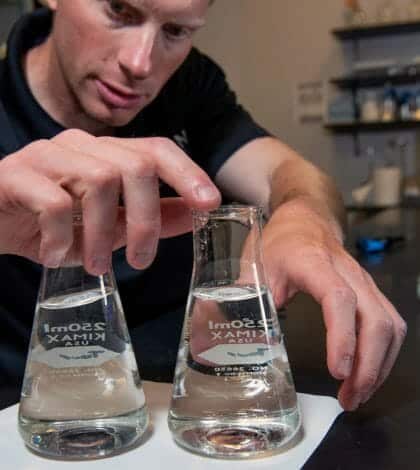Photo: Dr. Chaffin in the lab. (Credit: Ohio Sea Grant, Stone Laboratory, https://ohioseagrant.osu.edu/news/2018/7a1my/water-quality-safe.)
Harmful algal blooms (HABs) and the toxins they produce, threaten drinking water safety worldwide, and here in the US, we are becoming more aware of the issue as HABs are reported across the country. Microcystins, the most common toxins arising from HABs, can put animals and humans at risk. Human reactions to microcystins include mild skin rash, respiratory illness, kidney or liver damage and even death.
If you use a water-filter pitcher to ensure harmful microcystins aren’t present in your drinking water, recent research has both good news and bad news for you. First, the bad news: these water-filter pitchers vary substantially in how effectively they can remove harmful contaminants. However, the good news is, with the right kind of filter cartridge, you can count on your pitcher removing 100 percent of microcystins from your water.
Putting pitchers to the test
“I initially conceived of this project because we do a lot of educational outreach activities where we talk about harmful algal blooms (HABs), and at the end of my presentation or other people’s presentations we were getting that question a lot: does my water pitcher purifier filter out microcystins? explains senior researcher and research coordinator Ohio State University’s Stone Laboratory, Dr. Justin Chaffin. And our answer was, ‘Well, I don’t know, maybe.’ So that’s what really gave me the idea to do these experiments.”
Situated on Lake Erie, Stone Lab is a scientific hub for research on challenges facing the Great Lakes—and one of the most pressing is the issue of HABs. The team decided to put the household pitcher filter to the test.
They collected samples of water from Lake Erie containing several microcystin-producing bacteria. They observed the samples under a microscope to confirm which bacteria were present. The team then lysed the cells by subjecting the water samples to three freeze/thaw cycles and extracted the microcystins, measuring the concentration. They were thus able to use water with a known concentration of specific types of microcystins with the filter cartridges.
The team tested three different brands of pitchers, each with unique filter components, and each certified by NSF International/American National Standards Institute standards #42 and #53 for aesthetic and health effects—but not for microcystins.
They poured a set quantity of contaminated water in each pitcher, measuring both percolation time and microcystin levels after […]
Full article: Water-Filter Pitchers Not Equally Effective at Removing Microcystins


